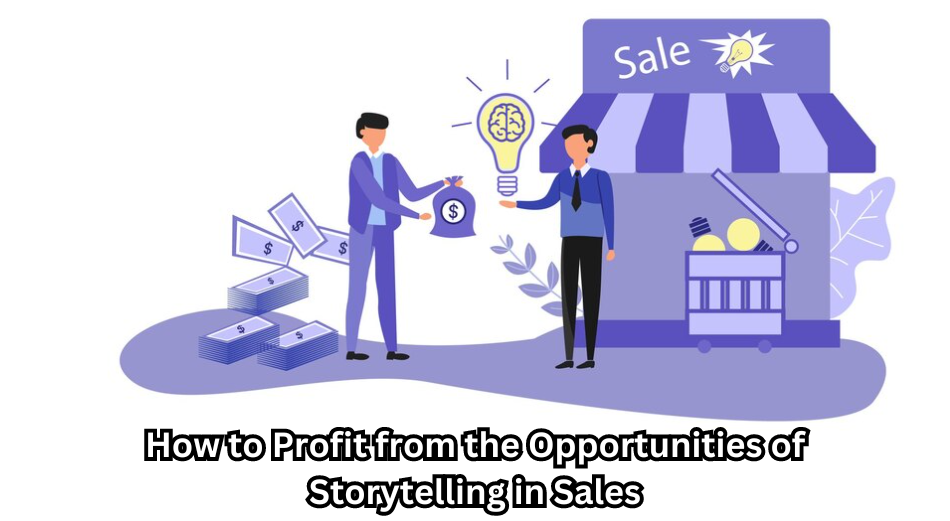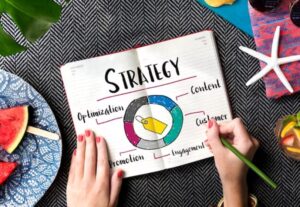Welcome to the dynamic world of sales, where numbers aren’t the only heroes of the story! Today, we’re diving into an exciting and often overlooked aspect of sales – storytelling. Gone are the days when sales were just about presenting data and waiting for a nod. In this modern era, storytelling in sales has emerged as a powerful tool to connect, engage, and convert. Let’s unfold the secrets of how storytelling can revolutionize your sales approach.

The Art of Storytelling in Sales
Storytelling in sales is about creating a narrative around your products and services that engages customers emotionally. It goes beyond the traditional sales pitch, weaving in elements that speak to the human experience, desires, and challenges. A good story can transport your audience, helping them see the real-world value and impact of what you’re offering.
Why Storytelling Resonates in Sales
Storytelling has become a powerful force in sales, captivating audiences and driving results. This section explores why storytelling is an art form and a strategic tool in sales, creating emotional connections, building trust, and transforming the traditional sales narrative. Here, we delve into the psychology behind storytelling’s impact and how it can be effectively harnessed to engage customers and enhance sales outcomes.
Emotional Connection and Engagement
People remember stories far more than they remember data. Integrating storytelling into your sales approach creates a stronger emotional connection with your audience. For example, don’t discuss the technical specifications if you sell a home security system. Instead, tell a story about how your system makes a family feel safer and more secure in their home.
Building Trust and Credibility
Stories can also build trust and credibility. You provide evidence of your product’s value when you share customer testimonials or case studies. For instance, sharing a story about how your software helped a small business streamline its operations and increase efficiency can build more credibility than just listing its features.
Elements of a Good Sales Story
A good sales story should have a clear structure, relatable characters, and a meaningful message. It should be tailored to address your audience’s specific needs and pain points while highlighting the benefits of your product or service.

Structure of a Compelling Story
The structure of a compelling sales story typically follows a classic narrative arc: setting the scene, introducing a conflict or problem, and then providing a resolution. For example, you might start with a story about a business struggling with low online engagement. The conflict is their current ineffective marketing strategy. The resolution is how your digital marketing services increased their online presence and customer engagement.
Creating Relatable Characters
Your story should include characters that your audience can relate to. This could be a fictional customer with challenges and goals similar to your target audience’s. For instance, if you’re selling educational software, your character could be a teacher struggling to keep students engaged until they start using your software.
Evoking Emotions and Solutions
Finally, your story should evoke emotions and provide solutions. If you’re selling eco-friendly products, tell a story about the impact of these products on the environment and how the character’s choice to use them reflects their values and commitment to sustainability.
Implementing Storytelling in Your Sales Process
Integrating storytelling into your sales process involves understanding your audience, crafting your narrative, and using storytelling techniques at different sales cycle stages.

Understanding Your Audience
Understanding your audience is crucial for effective storytelling. Research their interests, challenges, and motivations to create stories that resonate. For example, if your target audience is technology enthusiasts, your stories should highlight the innovative aspects of your product.
Tailoring Stories to Different Buyer Personas
Different buyer personas will relate to other stories. A busy executive might be drawn to a story about time-saving features, while a tech-savvy user might appreciate a story about the advanced technical capabilities of your product.
Research and Insights
Conduct thorough research to gather insights about your audience. This could involve market research, customer surveys, or analyzing customer feedback. The more you know about your audience, the more targeted and effective your stories will be.
Crafting Your Sales Story
Your sales story should align with your brand and be authentic and relevant to your audience. It should communicate the value of your product or service and how it can solve the audience’s problems or enhance their lives.
Aligning Stories with Your Brand
Ensure that your stories reflect your brand’s values and message. If your brand is all about innovation, your stories should highlight how your products or services are at the cutting edge of technology.
Keeping it Authentic and Relevant
Maintain authenticity in your storytelling. Your stories should be based on real-world scenarios and offer genuine solutions. Avoid exaggeration or misleading information, as this can damage your credibility.
Storytelling Techniques for Different Sales Stages
Effective sales storytelling varies by customer journey stage. To develop rapport, start with anecdotes about your brand’s beginnings or related consumer experiences. Customize your narratives to show your product’s worth and effect, utilizing customer success stories to meet unique needs or issues. Finish with fascinating anecdotes about the long-term advantages and happiness of choosing your product or service to motivate them to act.

Introduction and Rapport Building
At the beginning of your sales interaction, please share a story introducing your brand and its values. This could be a narrative about how your company was founded, highlighting the passion and commitment behind your products. For example, if you’re selling artisan coffee, start with how your founders traveled to different countries to source the best beans, emphasizing their dedication to quality and sustainability.
Presenting Solutions and Overcoming Objections
When presenting your product or service, use stories that showcase how it solves specific problems or improves lives. For instance, if you’re selling a project management tool, narrate how a previous client went from disorganized and stressed to completely streamlined and efficient thanks to your tool. When facing objections, tell stories that have addressed similar concerns, showing your product’s effectiveness in real-life scenarios.
Closing the Deal with a Strong Narrative
To close, share a success story that paints a vivid picture of the benefits of choosing your product or service. This could be a story about a customer who experienced significant improvements in their business or personal life after using your product, encouraging your prospect to envision similar success.
Measuring the Impact of Storytelling on Sales
Understanding the true impact of storytelling on sales is crucial for refining and optimizing this strategy. In this section, we discuss the methodologies and metrics essential for measuring the effectiveness of storytelling in the sales process. From tracking performance indicators to analyzing customer feedback, we’ll explore how to quantitatively and qualitatively assess storytelling’s role in enhancing sales outcomes and driving business growth.

Tracking Sales Performance
To gauge the effectiveness of storytelling in your sales process, track key metrics such as conversion rates, customer engagement, and customer feedback.
Key Metrics to Monitor
Monitor metrics like the sales cycle length, customer acquisition cost, and lifetime value. These metrics will help you understand how storytelling impacts sales efficiency and profitability.
Analyzing Storytelling Effectiveness
Regularly analyze which stories resonate most with your audience. Use customer feedback and sales data to identify which aspects of your storytelling are most effective and which need refinement.
Feedback and Continuous Improvement
Always seek feedback from your customers and sales team. This feedback is crucial for continuously improving your storytelling strategy.

Gathering Customer Insights
Collect and analyze customer feedback to understand how your stories are being received. This can be done through surveys, interviews, or analyzing customer reviews.
Adapting and Evolving Stories
Based on the feedback and insights gathered, adapt and evolve your stories. Keep them fresh and relevant to current market trends and customer needs.
Final Words
Incorporating storytelling into your sales strategy can profoundly impact customer connection, increasing engagement, trust, and sales. You can turn your sales process into an engaging story that captivates and converts by crafting compelling narratives, understanding your audience, and refining your approach. Remember, in the sales world, a good story is worth its weight in gold.
Frequently Asked Questions
What Makes a Good Sales Story?
A good sales story should have a clear structure with a beginning, middle, and end. It must be relatable, evoke emotions, and, most importantly, be relevant to the customer’s needs. The story should highlight how your product or service can solve a problem or improve the customer’s situation.
How Can I Tailor My Sales Stories to Different Audiences?
To tailor your sales stories effectively, you must first understand your audience’s unique needs, challenges, and aspirations. This means researching your customer base and creating buyer personas. Once you have this insight, you can craft stories that resonate specifically with each segment of your audience.
Are There Any Common Mistakes to Avoid in Sales Storytelling?
One common mistake is making the story too much about the product and not enough about the customer. Remember, connecting with the customer’s needs and emotions is the goal. Other mistakes include lack of authenticity, overcomplication, and not aligning the story with your brand’s values.
How Do I Measure the Effectiveness of Storytelling in My Sales Process?
The effectiveness of storytelling can be measured through various metrics such as conversion rates, customer engagement, and feedback—track changes in these metrics after incorporating storytelling into your sales process. Additionally, direct customer feedback can provide valuable insights into how your stories resonate.
Can Storytelling in Sales Be Used in Both B2C and B2B Contexts?
Absolutely! Storytelling is a versatile tool that can be effective in B2C and B2B sales. The key difference lies in the type of story you tell. B2C stories often focus more on emotional connections and personal benefits, while B2B stories might emphasize efficiency, ROI, and problem-solving capabilities.
Stay ahead in the dynamic world of sales with more insights and tips like these! Sign up for our weekly newsletter and get the latest strategies, success stories, and exclusive content delivered straight to your inbox. Don't miss out on the opportunity to elevate your sales game. Subscribe now and be part of a community passionate about mastering the art of sales.





